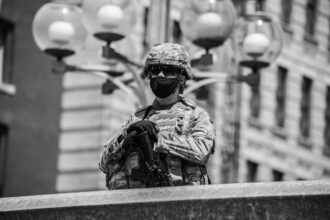Before the onset of World War II, the United States had a rudimentary intelligence infrastructure that was largely uncoordinated and fragmented. The nation relied on various military and civilian agencies, each operating independently without a cohesive strategy or centralized oversight. The Office of Naval Intelligence (ONI) and the Military Intelligence Division (MID) were among the few entities tasked with gathering and analyzing information, but their efforts were often hampered by a lack of resources and inter-agency communication.
This disjointed approach meant that the U.S. was ill-prepared for the complexities of global conflict, as intelligence operations were often reactive rather than proactive. As tensions escalated in Europe and Asia during the late 1930s, the need for a more robust intelligence framework became increasingly apparent.
The establishment of the Coordinator of Information (COI) in 1941 marked a significant shift in the U.S. approach to intelligence. This agency aimed to consolidate various intelligence efforts under a single umbrella, laying the groundwork for more effective operations.
However, it was still in its infancy when the attack on Pearl Harbor occurred, highlighting the urgent need for a comprehensive and coordinated intelligence strategy that could respond to the rapidly changing global landscape.
Key Takeaways
- The pre-war intelligence infrastructure laid the groundwork for the development of advanced intelligence operations during WWII.
- The impact of Pearl Harbor on intelligence operations led to a reevaluation of intelligence gathering and the need for improved coordination and communication.
- The emergence of the Office of Strategic Services (OSS) marked a significant shift towards centralized intelligence gathering and covert operations.
- The role of codebreaking in intelligence gathering played a crucial role in providing valuable information for military decision-making.
- The development of psychological warfare tactics demonstrated the importance of influencing enemy morale and behavior through strategic messaging.
The Impact of Pearl Harbor on Intelligence Operations
The attack on Pearl Harbor on December 7, 1941, served as a wake-up call for American intelligence operations. It exposed critical failures in the existing system, revealing how fragmented and ineffective U.S. intelligence had become. Despite having intercepted Japanese communications prior to the attack, the information was not adequately analyzed or acted upon, leading to a devastating surprise that resulted in significant loss of life and naval assets. This shocking event underscored the necessity for a more integrated and proactive intelligence apparatus capable of anticipating threats and providing timely warnings. In response to this intelligence failure, the U.S. government undertook sweeping reforms to enhance its intelligence capabilities. The establishment of the Office of Strategic Services (OSS) soon followed, which aimed to centralize intelligence efforts and improve coordination among various agencies. The lessons learned from Pearl Harbor prompted a reevaluation of existing practices, leading to increased funding, personnel training, and technological advancements in intelligence gathering. This pivotal moment not only transformed American intelligence operations but also set the stage for a more aggressive approach to espionage and counterintelligence throughout the war.
The Emergence of the Office of Strategic Services (OSS)

The Office of Strategic Services (OSS) emerged as a crucial player in American intelligence during World War II, founded in June 1942 under the leadership of William J. Donovan. The OSS was tasked with gathering and analyzing information about enemy forces while also conducting covert operations behind enemy lines.
Its creation marked a significant departure from previous intelligence efforts, as it sought to unify various aspects of intelligence work under one organization. This consolidation allowed for more effective planning and execution of operations that would ultimately shape the course of the war. The OSS quickly became known for its innovative approaches to intelligence gathering and its willingness to adapt to the evolving nature of warfare.
It employed a diverse range of tactics, including espionage, sabotage, and psychological warfare, to undermine enemy morale and disrupt their operations. The agency also established networks of operatives in occupied territories, facilitating the collection of vital information that would inform Allied strategies. As the war progressed, the OSS played an instrumental role in several key operations, including the D-Day invasion and efforts to support resistance movements across Europe.
The Role of Codebreaking in Intelligence Gathering
| Codebreaking Method | Impact on Intelligence Gathering |
|---|---|
| Frequency Analysis | Helps in breaking simple substitution ciphers |
| Brute Force Attack | Used to decrypt encrypted messages by trying all possible keys |
| Machine Learning Algorithms | Assist in identifying patterns and predicting potential encryption keys |
| Cryptanalysis | Provides methods to break complex encryption systems |
Codebreaking emerged as one of the most critical components of intelligence gathering during World War
The ability to decipher enemy communications provided invaluable insights into their strategies and intentions. The United States made significant investments in codebreaking efforts, particularly through organizations like the Army’s Signal Intelligence Service (SIS) and the Navy’s Cryptanalytic Unit. These agencies worked tirelessly to crack Japanese and German codes, leading to breakthroughs that would prove pivotal in several key battles.
One of the most notable successes in codebreaking was the interception and decryption of Japanese naval communications leading up to the Battle of Midway. By breaking the Japanese Navy’s code, American forces were able to anticipate their movements and mount a successful counteroffensive that turned the tide in the Pacific Theater. This victory underscored the importance of codebreaking as a strategic advantage in warfare, demonstrating how intelligence could directly influence military outcomes.
As a result, codebreaking became an integral part of military planning and operations throughout the war.
The Development of Psychological Warfare Tactics

Psychological warfare emerged as a vital tool in the arsenal of World War II intelligence operations. The OSS recognized that undermining enemy morale could be just as effective as traditional military tactics. To this end, they developed strategies aimed at sowing discord among enemy ranks and instilling fear within occupied populations.
Propaganda campaigns were launched to disseminate disinformation and create confusion among enemy forces, while leaflets and broadcasts targeted both soldiers and civilians. The effectiveness of psychological warfare was evident in various campaigns throughout the war. For instance, during the lead-up to D-Day, Allied forces employed extensive propaganda efforts to mislead German troops about the location and timing of the invasion.
By creating a false narrative that suggested an attack would occur elsewhere, they successfully diverted German resources and attention away from Normandy. This innovative approach not only contributed to the success of Allied operations but also highlighted how psychological tactics could complement traditional military strategies.
The Integration of Intelligence into Military Operations
As World War II progressed, the integration of intelligence into military operations became increasingly sophisticated. Commanders began to recognize that timely and accurate intelligence was essential for making informed decisions on the battlefield.
Intelligence officers were embedded within military units, ensuring that critical information could be relayed quickly and efficiently. The integration of intelligence into military operations was particularly evident during major campaigns such as Operation Overlord and Operation Market Garden. In these instances, intelligence assessments played a crucial role in determining troop deployments, supply routes, and overall strategy.
By leveraging real-time information from various sources—including aerial reconnaissance, human intelligence (HUMINT), and signals intelligence (SIGINT)—military leaders were able to adapt their plans dynamically in response to changing conditions on the ground.
The Expansion of Signals Intelligence (SIGINT) Capabilities
The expansion of Signals Intelligence (SIGINT) capabilities during World War II marked a significant advancement in how nations gathered information about their adversaries. As communication technologies evolved, so too did the methods employed by intelligence agencies to intercept and analyze enemy communications. The United States invested heavily in SIGINT operations, establishing dedicated units tasked with monitoring radio transmissions and deciphering coded messages.
One notable achievement in SIGINT was the development of advanced interception techniques that allowed American forces to monitor Japanese communications across vast distances in the Pacific Theater. This capability provided critical insights into enemy movements and intentions, enabling U.S. forces to respond effectively to threats.
Additionally, SIGINT played a vital role in tracking German U-boat activity in the Atlantic Ocean, contributing to successful anti-submarine warfare efforts that ultimately secured vital supply routes for Allied forces.
The Use of Ultra Intelligence in Allied Strategy
Ultra Intelligence represented one of the most significant breakthroughs in Allied intelligence during World War
The impact of Ultra Intelligence was particularly evident during key battles such as El Alamein and Normandy. By understanding German strategies through intercepted communications, Allied forces were able to anticipate enemy actions and exploit weaknesses effectively. The successful use of Ultra not only contributed to military victories but also underscored the importance of collaboration between Allied nations in sharing critical intelligence resources.
The Influence of Intelligence on the Manhattan Project
Intelligence operations during World War II extended beyond traditional military applications; they also played a crucial role in scientific endeavors such as the Manhattan Project. As concerns about Nazi Germany’s potential development of atomic weapons grew, U.S. intelligence agencies worked diligently to gather information on enemy research efforts related to nuclear technology.
This included monitoring scientific developments in Germany while also assessing potential threats posed by other nations. The insights gained from these intelligence efforts informed decisions regarding resource allocation for the Manhattan Project itself. Understanding that Germany was pursuing similar research prompted U.S.
leaders to prioritize their own atomic bomb development program aggressively. As a result, intelligence not only shaped military strategies but also influenced groundbreaking scientific advancements that would have lasting implications for global politics in the post-war era.
The Legacy of WWII Intelligence Operations
The legacy of World War II intelligence operations is profound and far-reaching. The lessons learned during this tumultuous period laid the groundwork for modern intelligence practices and shaped how nations approach national security today. The establishment of organizations like the Central Intelligence Agency (CIA) after the war reflected an understanding that effective intelligence gathering is essential for safeguarding national interests.
Moreover, World War II highlighted the importance of collaboration among allied nations in sharing intelligence resources and expertise. The partnerships forged during this time set a precedent for future international cooperation on security matters, emphasizing that collective efforts are often more effective than isolated actions when addressing global threats.
The Evolution of US Intelligence Agencies in the Post-War Era
In the aftermath of World War II, U.
intelligence agencies underwent significant transformations as they adapted to new geopolitical realities during the Cold War era. The establishment of the CIA in 1947 marked a pivotal moment in this evolution, as it centralized many functions previously scattered across various agencies into one cohesive organization focused on foreign intelligence gathering and analysis.
As global tensions escalated between superpowers, U.S. intelligence agencies expanded their capabilities further by investing in advanced technologies such as satellite reconnaissance and electronic surveillance systems. These developments allowed for more comprehensive monitoring of adversaries while also enhancing domestic security measures against potential threats from within.
The evolution of U.S. intelligence agencies post-war reflects an ongoing commitment to adapting strategies based on lessons learned from past conflicts while remaining vigilant against emerging challenges on both national and global fronts. As history has shown time and again since then—effective intelligence remains crucial for ensuring national security amidst an ever-changing landscape characterized by complex threats requiring innovative solutions.
During World War II, the United States intelligence community underwent significant transformations that laid the groundwork for modern intelligence operations. The Office of Strategic Services (OSS), established in 1942, played a crucial role in gathering and analyzing intelligence, conducting espionage, and supporting resistance movements across Europe and Asia. For a deeper understanding of the evolution of US intelligence during this pivotal period, you can explore a related article on the history of US intelligence in WWII by visiting In The War Room. This resource provides valuable insights into the strategies and operations that shaped the future of American intelligence services.
WATCH THIS! 😱The Nazi Trial America Never Wanted You To See 😱
FAQs
What was the role of US intelligence during World War II?
During World War II, US intelligence played a crucial role in gathering and analyzing information about enemy movements, plans, and capabilities. This information was used to support military operations, strategic decision-making, and to protect national security.
What were the major intelligence agencies in the US during World War II?
The major intelligence agencies in the US during World War II were the Office of Strategic Services (OSS), the Federal Bureau of Investigation (FBI), and the Signal Intelligence Service (SIS), which later became the Army Security Agency (ASA).
What were some key intelligence operations during World War II?
Some key intelligence operations during World War II included code-breaking efforts at Bletchley Park, the gathering of human intelligence through espionage and resistance movements, and the use of aerial reconnaissance to gather information about enemy positions and movements.
How did US intelligence contribute to the Allied victory in World War II?
US intelligence contributed to the Allied victory in World War II by providing critical information about enemy intentions, capabilities, and vulnerabilities. This information helped to shape military strategy, support successful military operations, and protect Allied forces from enemy threats.
What were some challenges faced by US intelligence during World War II?
Some challenges faced by US intelligence during World War II included the difficulty of gathering accurate and timely information in a rapidly changing and complex wartime environment, the need to protect intelligence sources and methods from enemy detection, and the coordination of intelligence efforts across multiple agencies and theaters of operation.




